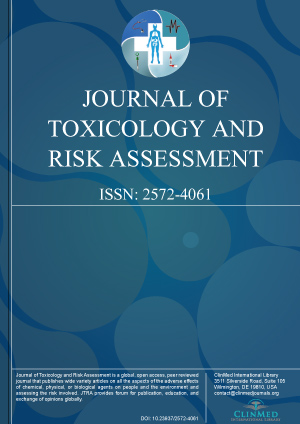Open Access DOI:10.23937/2572-4061.1510054
The Mechanism of the Toxic Organic Halides Disposal under the Catalytic Influence of the Vitamin B12
Tudor Spataru, Theodor Dumitrescu, Mariana Moraru, Francisco Fernandez and Petru Spataru
Article Type: Research Article | Indexed Archive: Volume 9
Organic halide toxic compounds have penetrated into all natural environments, including natural waters and soil, due to industrial and agro-industrial activity, becoming an obvious danger to human and animal health. One of the factors that can dispose of toxic organic halide compounds is the catalytic activity of the cob(I)alamin cofactor of vitamin B12 through direct or bacterial action. ...
Open Access DOI:10.23937/2572-4061.1510053
Environmental Impacts and Health Risks of Open Landfills in West African Countries: A Systematic Review of the Literature
Robert FAOMOWE FOKO, El Hadj Malick KANE, Fatoumata BAH, Absa LAM, Cheikh DIOP, Mamadou FALL, Aminata TOURE and Mathilde CABRAL
Article Type: Review Article | Indexed Archive: Volume 9
In developing countries, despite the fact that most waste is composed mainly of materials of plant origin, the increasing industrialization of communities is increasingly involved in the generation of waste from industrial and agricultural activities and chemical remains. One of the consequences associated with the production of this waste is the emergence of open landfills as a disposal method, which has the effect of releasing several pollutants into the environment, including toxic metals. .....
Open Access DOI:10.23937/2572-4061.1510042
Biochemical Changes in Hematological and Liver Parameters in Albino Rats Exposed to Azo Dye Adulterated Palm Oil
Kola-Ajibade Ibukun R, Jegede Rotimi J and Olusola Augustine O
Article Type: Original Article | Indexed Archive: Volume 7
In West Africa, the manufacturing and processing of palm oil are done on a small, medium, and large scale, it is therefore almost impossible to detect fraud in the system. A major disadvantage associated with the use of adulterants in palm oil is that the adulterants have not undergone adequate research and the degree of health hazards they can pose to humans when consumed. This study was designed to evaluate the toxic effects of azo dye adulterated palm oil on hematological and liver parameters...
Open Access DOI:10.23937/2572-4061.1510039
Toxic Metal Profiles, Carcinogenic and Non-Carcinogenic Human Health Risk Assessment of Some Locally Produced Beverages in Nigeria
Odangowei I Ogidi, Uchechi E Enenebeaku, Ebifanimi Okara and Stephanie A Elumelu
Article Type: Research Article | Indexed Archive: Volume 7
Toxic metal contamination is a major problem of our environment and they are also one of the major contaminating agents of our food supply. The knowledge of metals in foods is essential for calculating the dietary intakes of essential metals and evaluation of human exposure to toxic elements. The aim of this study was to assess the toxic metal profiles, carcinogenic and non-carcinogenic human health risk of some locally produced beverages in Nigeria. Seven (7) samples of locally produced beverag...
Open Access DOI:10.23937/2572-4061.1510037
Serum Glucose, Bilirubin, Liver Enzymes, Renal Parameters, Protein Profile and Some Electrolytes in Adult Male Domestic Rabbits Intoxicated with Chlorpyrifos
Maged M Yassin, Tareq O Adas and Mohammed M Yasin
Article Type: Review Article | Indexed Archive: Volume 7
Chlorpyrifos is a broad-spectrum chlorinated organophosphate pesticide with a multipurpose use worldwide. However, its use and/or misuse could put a real threat on non-targets including humans and domestic animals. To assess the toxic effect of chlorpyrifos on serum glucose, bilirubin, liver enzymes, renal parameters, protein profile, and some electrolytes in adult male domestic rabbits. The oral LD50 of chlorpyrifos was determined, and then a daily dose of 1/10 LD50 was given orally to rabbits ...
Open Access DOI:10.23937/2572-4061.1510036
Recent Advances on Renal Toxicity of Engineered Nanoparticles-A Review
Suresh VS Rana
Article Type: Review Article | Indexed Archive: Volume 7
Kidney is considered as the secondary target organ of nanoparticle (NP) toxicity. Since it is the primary organ of excretion, NPs are expected to adversely affect the renal system. Therefore, a comprehensive review of recent knowledge on renal toxicity of engineered nanoparticles (ENPs) was made. Mechanistic paradigms of their toxicity have also been discussed. In vitro and in vivo studies indicated that carbon nanotubes (CNT) caused cytotoxicity, glomerular degeneration and proximal tubular nec...

